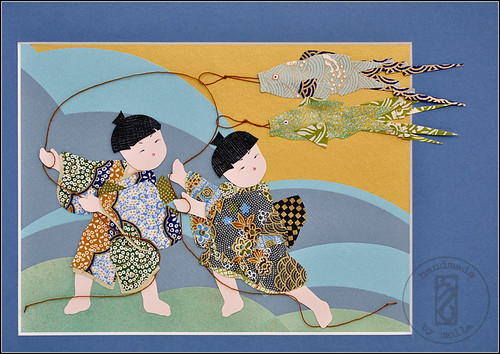I’ve been experimenting with new theme and colour combinations. It was great challenge for me to start such theme unknown in my creations so far. I`ve been prefering cute japanese girls with their red cheeks and lovely round faces. My friend made me eager to do something new. So there is, potrait of two boys struggling with koinobori (carp flags) on wind.
My goal was to achieve movement, activity, get vivid composition to capture energy, vitality and envolvement of these little boys. I used many, many little pieces of japanese paper for children and kites shapes, everything was glued carrefully for seamless and neat effect. These operations took many hours, but these time owing decision about change artwork theme I think I gain little step for progress in my paper creation.
Carp fish (koi) are used as festive decorations during Children's Day ( Kodomo no hi). This is a Japanese national holiday which takes place annually on May 5, the fifth day of the fifth month. It is a day set aside to respect children's personalities and to celebrate their happiness.
The day was originally called Tango no Sekku and was celebrated on the 5th day of the 5th moon in the lunar calendar or Chinese calendar. After Japan's switch to the Gregorian calendar, the date was moved to May 5.
Sekku means a season's festival (there are five sekku per year). Tango no Sekku marks the beginning of summer or the rainy season. Tan means "edge" or "first" and go means "noon". In Chinese culture, the fifth month of the Chinese calendar was said to be a month for purification, and many rites that were said to drive away evil spirits were performed.
Before this day, families raise the carp-shaped koinobori flags (carp because of the Chinese legend that a carp that swims upstream becomes a dragon, and the way the flags blow in the wind looks like they are swimming), one for each boy (or child), display a Kintarō doll usually riding on a large carp, and the traditional Japanese military helmet, kabuto. Kintarō boy and the kabuto are symbols of a strong and healthy boy.




bardzo fajne połączenie kolorów, aż czuć ten wiatr :) zachciało mi się zrobić rybi latawiec :))))
OdpowiedzUsuńmuszę wpisać sobie takie papierowe wycinanki* na listę rzeczy do zrobienia, bo zbieram się do tego jak pies do jeża!! ...i choć na pewno Ci nie dorównam pewnie to fajna zabawa :))
*przepraszam za takie określenie, nie wiem jak to nazwać :O
beautiful artwork!
OdpowiedzUsuńNati from Brazil
http://natiquill.blogspot.com
Mariola, bardzo fajne naprawdę.kolorystyka świetna. super zr ruszylaś nowy temat :)
OdpowiedzUsuńThis is very interesting and beautiful!
OdpowiedzUsuńYou capture the moment,and describe the moment vividly.It is technically elaborate.
Piękne..............
OdpowiedzUsuń